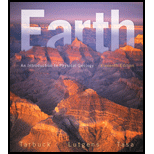
The way in which the two major categories of weathering are represented in the given image of human-made objects.
Answer to Problem 1GST
The broken glass pieces in the image portray mechanical weathering, and the rusted metallic cans depict chemical weathering.
Explanation of Solution
Weathering may be defined as the “physical breakdown and chemical alteration of rocks at or near to the Earth’s surface.” Weathering could be divided into two significant types namely the mechanical weathering and chemical weathering.
Mechanical weathering pertains to the disintegration of rocks into simpler and smaller particles without promoting alteration in the mineral chemistry of the undergoing rocks. The weathering of rocks that encompasses the chemical conversion of rocks into one or more newer products is termed as chemical weathering.
The image provided shows broken glass pieces and corroded metallic cans. The broken glass pieces that may be obtained from the breaking of glass bottles represent the mechanical weathering. The pieces of glass have not undergone any chemical alteration than getting broken into small pieces. There are some round-edged glass pieces that show the abrasion which took place through the passage of time.
The corroded and rusted metallic cans represented the chemical weathering where the metallic cans suffered chemical transformation into rust (hydrated iron (III) oxides), when exposed to atmospheric oxygen and moisture for a long period of time.
Want to see more full solutions like this?
Chapter 6 Solutions
Earth: An Introduction to Physical Geology
- N (120') -1180- (120') (105') 0 50 100 feet 1160- -1140- A (100') B (90') (80) Proposed well -1120. (95) (80°) (80') 1100 Well location (Depth to top of water table) A Figure 8.14 Hypothetical topographic map showing the locations of several water wells. The numbers in parentheses indicate the depth of the water table below the surface in each well.arrow_forwardDue tomorrow 3/27 2 pm if you could give me detailed solutions pleasearrow_forwardDue 3/27 at 2pmarrow_forward
- Based on the Climate-Change Censorship campaign article (WSJ) does the phenomenon of scientific certainty ever exist? Why or why not?arrow_forwardBased on the Climate-Change Censorship campaign article (WSJ) some think that twitter, snapchat, instagram, facebook, google, messenger, et al. are the new forums for public discourse. Should the big tech company owners of these sites be allowed to censor the information and comments posted by the public?arrow_forwardHow does radon enter a home?arrow_forward
 Applications and Investigations in Earth Science ...Earth ScienceISBN:9780134746241Author:Edward J. Tarbuck, Frederick K. Lutgens, Dennis G. TasaPublisher:PEARSON
Applications and Investigations in Earth Science ...Earth ScienceISBN:9780134746241Author:Edward J. Tarbuck, Frederick K. Lutgens, Dennis G. TasaPublisher:PEARSON Exercises for Weather & Climate (9th Edition)Earth ScienceISBN:9780134041360Author:Greg CarbonePublisher:PEARSON
Exercises for Weather & Climate (9th Edition)Earth ScienceISBN:9780134041360Author:Greg CarbonePublisher:PEARSON Environmental ScienceEarth ScienceISBN:9781260153125Author:William P Cunningham Prof., Mary Ann Cunningham ProfessorPublisher:McGraw-Hill Education
Environmental ScienceEarth ScienceISBN:9781260153125Author:William P Cunningham Prof., Mary Ann Cunningham ProfessorPublisher:McGraw-Hill Education Earth Science (15th Edition)Earth ScienceISBN:9780134543536Author:Edward J. Tarbuck, Frederick K. Lutgens, Dennis G. TasaPublisher:PEARSON
Earth Science (15th Edition)Earth ScienceISBN:9780134543536Author:Edward J. Tarbuck, Frederick K. Lutgens, Dennis G. TasaPublisher:PEARSON Environmental Science (MindTap Course List)Earth ScienceISBN:9781337569613Author:G. Tyler Miller, Scott SpoolmanPublisher:Cengage Learning
Environmental Science (MindTap Course List)Earth ScienceISBN:9781337569613Author:G. Tyler Miller, Scott SpoolmanPublisher:Cengage Learning Physical GeologyEarth ScienceISBN:9781259916823Author:Plummer, Charles C., CARLSON, Diane H., Hammersley, LisaPublisher:Mcgraw-hill Education,
Physical GeologyEarth ScienceISBN:9781259916823Author:Plummer, Charles C., CARLSON, Diane H., Hammersley, LisaPublisher:Mcgraw-hill Education,





